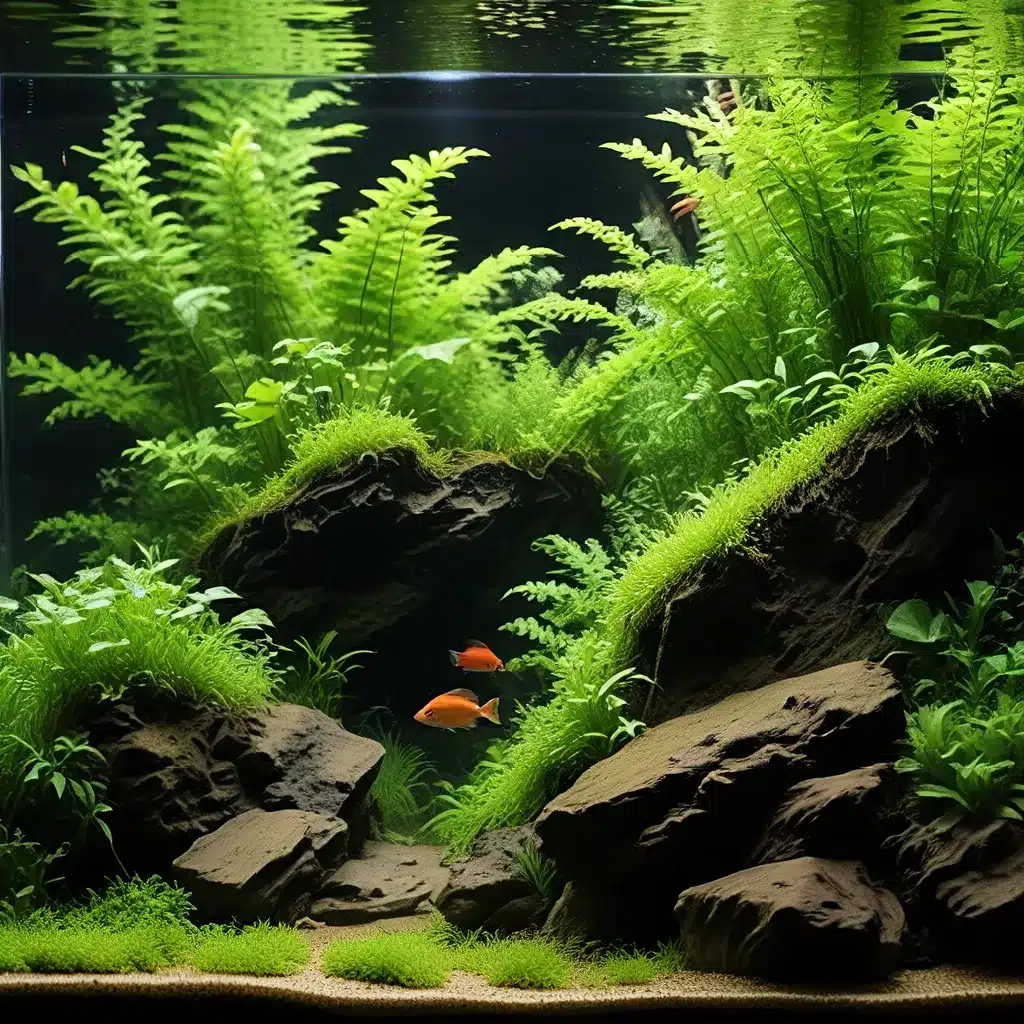
Choosing the Right Aquarium Size and Material
When it comes to setting up a successful planted aquarium, the size and material of your tank are crucial considerations. The larger the aquarium, the more stable the water parameters will be, making it easier to maintain optimal conditions for your aquatic plants and fish.
Aquarium enthusiasts generally recommend starting with a tank size of 20 gallons or more, as smaller setups under 10 gallons can be challenging to keep in balance. A 20- to 40-gallon tank provides ample space for a lush plantedscape, while still remaining manageable for beginner hobbyists.
When selecting the tank material, glass is the preferred choice over acrylic. Glass is more scratch-resistant, does not yellow over time, and is less prone to chemical absorption. This ensures your aquarium maintains its clarity and aesthetic appeal for years to come. Additionally, the rigid panels of a glass tank create a seamless look that complements the natural beauty of a planted aquascape.
Mastering Water Parameters for a Thriving Planted Tank
Achieving the proper water chemistry is essential for the long-term health and vigor of your aquatic plants. Three key parameters to monitor are pH, general hardness (GH), and carbonate hardness (KH).
For a planted aquarium, the ideal pH range is between 6.0 and 7.5, with a target of around 6.8-7.2. This moderately acidic to neutral environment supports the optimal growth and nutrient uptake of most aquatic plants. Maintaining stable pH levels is crucial, as fluctuations can stress your plants and fish.
General hardness (GH) measures the concentration of dissolved minerals, primarily calcium and magnesium, in the water. Aim for a GH range of 4-8 dKH, which provides the necessary nutrients for plant growth without being too hard on sensitive species.
Carbonate hardness (KH) represents the water’s ability to resist pH changes. Keeping your KH between 3-6 dKH helps to stabilize the pH, preventing rapid swings that can disrupt your aquarium’s delicate ecosystem.
To achieve and maintain these ideal water parameters, consider using a reverse osmosis (RO) or deionized (DI) water source, and then remineralizing it with appropriate supplements. This allows you to start with a clean, predictable baseline and then adjust the water chemistry as needed to suit your chosen plant species.
Selecting the Right Aquarium Plants
Choosing the right plants for your planted aquarium is crucial for creating a thriving, balanced ecosystem. As a beginner, focus on selecting hardy, fast-growing species that are well-suited to your tank’s lighting, water parameters, and aquascaping style.
Foreground/Carpet Plants:
– Java Moss (Taxiphyllum barbieri): An easy-to-maintain moss that can cover surfaces and create a lush, carpeted look.
– Dwarf Hairgrass (Eleocharis parvula): A delicate, grass-like plant that forms a dense, low-growing carpet.
Midground Plants:
– African Water Fern (Bolbitis heudelotii): A graceful fern with delicate, translucent leaves.
– Wendt’s Water Trumpet (Cryptocoryne wendtii): A hardy plant with varied leaf colors and textures.
Background Plants:
– Anacharis (Elodea canadensis): A fast-growing stem plant that helps oxygenate the water.
– Dwarf Rotala (Rotala rotundifolia): A vibrant, red-tinged stem plant that adds depth and color.
Floating Plants:
– Water Lettuce (Pistia stratiotes): A floating plant with waxy, green leaves and dangling roots.
When planning your plant arrangement, consider the height, growth habits, and light requirements of each species. Arrange taller plants in the back, medium-sized plants in the middle, and low-growing carpeting species in the front to create a visually stunning, layered aquascape.
Providing the Proper Lighting and Filtration
Adequate lighting is essential for the health and growth of your aquatic plants. As a general rule, aim for a lighting intensity of 2-3 watts per gallon of water. LED lighting is an energy-efficient and versatile option that allows you to fine-tune the spectrum and intensity to suit your plants’ needs.
In addition to lighting, a reliable filtration system is crucial for maintaining water quality and removing waste products that can hinder plant growth. Canister filters are a popular choice for planted aquariums, as they offer large media capacities and customizable filter media to promote beneficial bacterial growth.
When setting up your filtration, consider incorporating mechanical, biological, and chemical filtration media to create a comprehensive system. This helps remove debris, break down organic compounds, and control water parameters like pH and nutrient levels.
Introducing Fish and Invertebrates
Incorporating fish and invertebrates into your planted aquarium can provide numerous benefits, such as adding visual interest, contributing to the ecosystem’s natural balance, and even helping to maintain water quality.
When choosing fish species, opt for peaceful, community-friendly options that won’t uproot or consume your carefully planted aquascape. Some excellent choices include:
- Tetras (Hemigrammus, Paracheirodon): Schooling fish that add splashes of vibrant color.
- Betta Fish (Betta splendens): A solitary, long-finned fish that can thrive in a planted tank.
- Corydoras Catfish (Corydoras spp.): Bottom-dwelling scavengers that help keep the substrate clean.
In addition to fish, consider adding shrimp, snails, or other invertebrates to your planted aquarium. These “cleanup crew” members will help control algae growth and maintain a balanced ecosystem.
Ongoing Maintenance and Care
Maintaining a thriving planted aquarium requires a consistent routine of water changes, plant trimming, and equipment monitoring. Aim to perform a 10-25% water change weekly to replenish essential nutrients and remove waste buildup.
Trim your plants regularly to prevent overgrowth and maintain the desired aquascape. This not only keeps your tank looking tidy but also encourages new growth and prevents the plants from shading each other.
Regularly check your water parameters, and make adjustments as needed to keep your pH, GH, and KH within the optimal ranges. Supplement with liquid fertilizers or CO2 systems if your plants show signs of nutrient deficiencies or stunted growth.
By following these guidelines and adapting your maintenance routine to the specific needs of your planted aquarium, you’ll be well on your way to creating a thriving, sustainable ecosystem that provides endless hours of enjoyment and relaxation.

